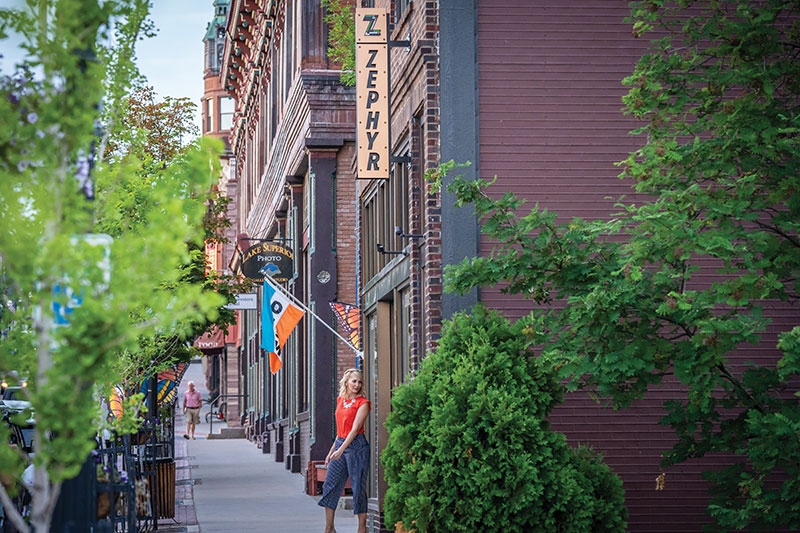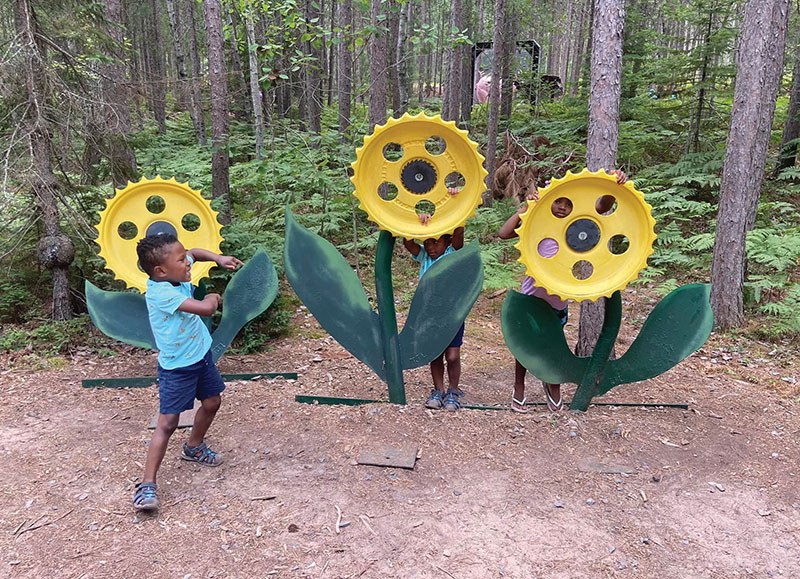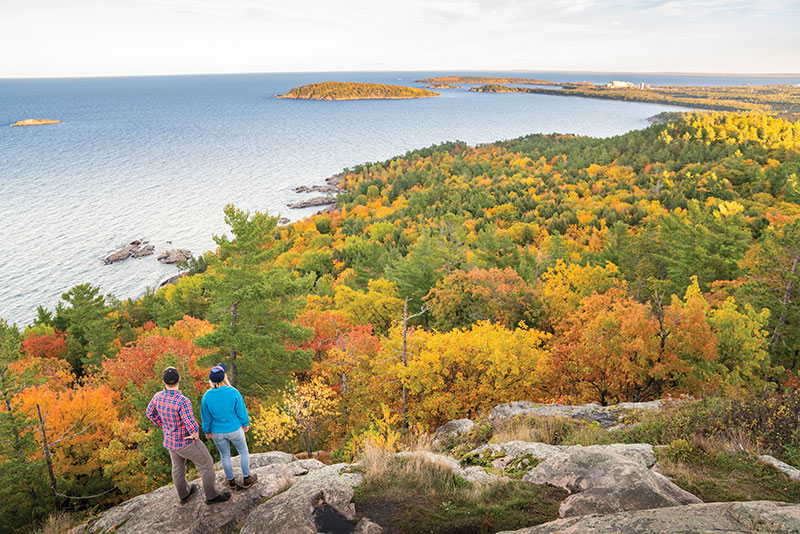Photo by Aaron Peterson
Marquette, Michigan, on Lake Superior’s south shore, captivates with its mix of culture, creature comforts, the great outdoors and a chance to see the Northern Lights.
 Until Shawn Malone moved from Chicago to Michigan’s Upper Peninsula, the Aurora Borealis had never displayed its mesmerizing dance in the sky above Lake Superior. Of course, it only seems the Northern Lights were “discovered” when her photos of the phenomenon started earning international attention, notably in her Smithsonian award-winning time-lapse video in 2013. Now, the U.P.’s largest city is a magnet for aurora-chasers who make the trek to what Malone considers one of the best places in the U.S. for viewing the elusive, colorful sky shows.
Until Shawn Malone moved from Chicago to Michigan’s Upper Peninsula, the Aurora Borealis had never displayed its mesmerizing dance in the sky above Lake Superior. Of course, it only seems the Northern Lights were “discovered” when her photos of the phenomenon started earning international attention, notably in her Smithsonian award-winning time-lapse video in 2013. Now, the U.P.’s largest city is a magnet for aurora-chasers who make the trek to what Malone considers one of the best places in the U.S. for viewing the elusive, colorful sky shows.
The owner of Lake Superior Photo Gallery in downtown Marquette doesn’t take credit for the explosion of interest in seeing — and photographing — the aurora.
“It has to do with timing,” Malone says. “I was doing it before everyone had a camera.”
With film, there was no way of getting instant feedback on photos, but the proliferation of digital has made shooting the night sky a hot pastime — as evidenced by Malone’s sold-out photo workshops and customized private classes, offered on location across the U.P.
Susan Estler, executive director of Travel Marquette, says that the aurora is definitely a draw for visitors. Fall through the winter is the prime viewing period, but catching a glimpse can be difficult because of cloud cover and other factors. “It’s all up to Mother Nature,” she says. “We make no guarantees.”
Cool, salubrious air
Mother Nature does guarantee a four- season playground in a spectacular setting of woods and water that satisfies hardcore mountain bikers and casual hikers, cross-country skiers and kayakers. And while ice climbing and winter surfing Lake Superior have their devotees, “The majority of people who visit come for soft adventure,” Estler says. “They’re looking for the natural beauty that we have, along with good restaurants and nice places to stay.” The modern comforts, she adds, “are five minutes from any outdoor activity you can think of.”
According to a description from 1878 (on p. 59), Marquette’s charms — “the rugged hills, the rocky gorges, the impenetrable glens, the picturesque lakes and beautiful waterfalls” — are just as appreciated today. A Travel Marquette map highlights a dozen of the area’s 70 waterfalls that are within fairly easy reach. Hikers head up Sugarloaf (easy-to-moderate) and Hogback (strenuous) mountains, and follow an accessible path to Thomas Rock Scenic Overlook for views that stretch for miles.
Beloved Presque Isle (almost island) Park is a 323-acre destination for a picnic, a sunset, or a stroll on the paved perimeter road or wooded trail through the park’s interior. Jumping from the rugged shore’s billion-year-old Black Rocks into Lake Superior is a rite of passage despite the risks of the 15-foot plunge into the chilly water. Most of the park is undeveloped, just as Frederick Law Olmsted, designer of New York City’s Central Park, recommended in 1891 when he turned down the opportunity to put his stamp on it. Calling Presque Isle “exceedingly interesting, beautiful and picturesque;” it should not, he said, be “marred by the intrusion of artificial objects.”

Photo by Aaron Peterson
Photo Courtesy of Travel Marquette
 Past is present
Past is present
A statue of Father Jacques Marquette, a 17th century French explorer and Jesuit priest, overlooks his namesake city and the defunct Lower Harbor Ore Dock. The settlement was built on iron ore, which was discovered in nearby Negaunee in 1844. With its natural harbor, Marquette became a shipping center that still handles about 10 million tons of ore each year from the 1,250-foot-long Presque Isle Dock at the Upper Harbor. Clark Lambros Beach Park is a comfortable spot for watching the freighters being loaded.
The out-of-commission ore dock that dominates the waterfront at Mattson Lower Harbor Park is an imposing reminder of the industry whose wealth built handsome homes of the Arch and Ridge Streets Historic District and stunning, red sandstone buildings that dot downtown. The story of Marquette, its people and industries unfold at the Regional History Museum and its guided walking tours, the Michigan Iron Industry Museum, Cliffs Mine Shaft Museum, Marquette Maritime Museum and its cheery red lighthouse, and Beaumier Upper Peninsula Heritage Center at Northern Michigan University.
Nancy Hamilton Musser, who I spoke to following a U.P. lighthouse tour, was impressed with the Maritime Museum and loved the beacons at Marquette and Big Bay Point. The 1896 Big Bay light, about 35 miles north of Marquette, is a year-round bed & breakfast. Guests can climb the tower for the view from 120 feet above Lake Superior.
Big Bay was the crime scene that influenced a novel by local attorney and judge John Voelker (pen name Robert Traver). “Anatomy of a Murder” became a 1959 movie starring James Stewart, Lee Remick, George C. Scott, Eve Arden and Ben Gazzara. Director Otto Preminger filmed largely on location; a free brochure from Travel Marquette has a self-guided tour to film sites, including the Marquette County Courthouse.

Photo Courtesy of Lakenenland Facebook
Culture on tap
For a city of fewer than 21,000, Marquette offers plenty of culture, coffee, culinary surprises and a growing beer community. The Vierling, known for its local whitefish served in an 1880s saloon, was the area’s first brewpub, followed by more than a half-dozen breweries and counting. Janet Pitrone Kasic, who I spoke to after a summertime visit of Marquette, especially enjoyed Blackrocks Brewery’s live music, energy and vibe on the spacious outdoor patio.
Marquette’s must-try traditional foods include pasties, the meat and root vegetable pies of miners, and Italian cudighi sausage, which is scarce outside of this region. The foodie scene also dishes farm-to-table takes on American classics, Vango’s time-tested pizza, house-smoked brisket, BBQ and international flavors. Historic Donckers is a sweet shop with an old-fashioned soda fountain and family friendly menu, while Zephyr Wine Bar specializes in small plates and charcuterie. The coffee is always on at a variety of java joints and cafes, each with a different ambiance, from rustic and warm BabyCakes Muffin Company to the sleek and modern 231 West Patisserie and colorful, eclectic Midwest Bakery & Cafe.
The historic Delft Theater, which opened in 1914 and thrilled visitors with on-screen performances, continues to entertain guests with its new-American menu featuring local ingredients. Try the popular cheese curds, poutine and The Feature Burger, all while watching a movie on the big-screen TV.
Independent shops in the walkable downtown and the Third Street neighborhood feature local art, home goods, handcrafted jewelry, clothing, imports and books. Each month, from June through October, about a dozen studios and galleries are open for Marquette’s First Thursdays Art Walk.
Public art is popping up around town in murals on themes of Native Anishinaabe heritage, cooperation and nature. At DeVos Art Museum on the campus of NMU, the collection includes Native American artifacts, Japanese wood block prints and contemporary works. The Marquette Symphony Orchestra is celebrating its 25th season, and in summer months the Lake Superior Theatre presents plays and concerts in a 1926 boathouse.
Wacky aspects of U.P. culture are the theme of Da Yoopers Tourist Trap roadside attraction, and at Lakenenland, where welder Tom Lakenen created a free park to share more than 100 sculptures he’s made from scrap metal. It’s just a short drive from his “junkyard art” to Munising and the 42-mile long, nature-painted Pictured Rocks National Lakeshore.
“From the biggest city in the U.P. you can be in wilderness, lost in the woods, in 15 minutes,” Malone says.
It’s that combination of nature and convenience of Marquette that make it so desirable.
2022 Events
 JANUARY
JANUARY
21-23: Noquemanon Marathon: Cross-country ski event with races from 1K to 50K.
FEBRUARY
17-21: UP 200, Midnight Run & Jack Pine 30 Sled Dog Races: Exciting competitions for 12-, eight- and six-dog teams.
18-22: Meijer State Games of Michigan: Skiing, curling, figure skating, luge, hockey and more.
JUNE
20-25: Marquette Art Week: Studio tours, exhibits, street performers and an evening art stroll.
JULY
22-24: Hiawatha Traditional Music Festival: Live performances and workshops in roots music.
30-31: Art on the Rocks: Juried fine arts show at the Lake Superior waterfront.
SEPTEMBER
10: U.P. Fall Beer Festival: More than 80 Michigan breweries pour samples.
Photo Courtesy of UP 200, Midnight Run & Jack Pine 30 Sled Dog Races Facebook



 Past is present
Past is present